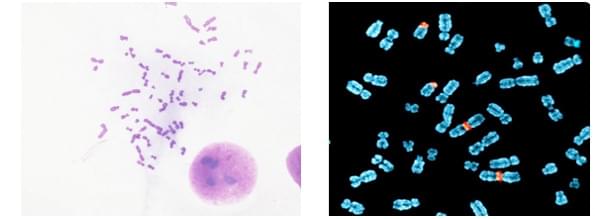FISH Slide Making Protocol for Metaphase Spreads
Metaphase preparation’s quality is a critical parameter for fluorescent in situ hybridization (FISH) methodologies. This protocol can be used for metaphase preparation from some kinds of cell lines. And this protocol is just for reference only. At Creative Bioarray, we can provide services for entire FISH process with unprcedented analytical accuracy, you can find more at Creative Bioarray’s Histology Services.

| 1) | Cells culture should be sub-confluent and in an exponentially growing phase. Change medium 4 hours prior to start of experiment. |
| 2) | Incubate cells with 100 μl colcemid in 5 ml of medium for 3h in order to arrest cells in the metaphase stage. |
| 3) | Wash cells once with PBS and then trypsinise cells as usual, collect in a 15 ml tube and spin down for 5 minutes at 800 rpm. |
| 4) | Remove supernatant carefully. |
| 5) | Snap the tube to loosen the pellet. Add 1 ml of pre-warmed (37°C) 0.56% KCl dropwise. Snap the pellet gently to get a uniform suspension. Add an additional 4 ml 0.56% pre-warmed KCl and incubate for 10 minutes at 37°C. |
| 6) | Centrifuge the tube at 800 rpm for 5 minutes and remove the supernatant carefully. |
| 7) | Snap the tube to loosen the pellet. Add 1-1.5 ml of ice-cold fixative (MeOH: Acetic acid= 3:1, prepared fresh and ice cold) to the above tube. Transfer the contents of the tube to a 1.5 ml tube. Centrifuge at 6000 rpm for 1 minute and carefully remove the supernatant. Repeat this step two to three times. |
| 8) | Resuspendin fixative (about 1 ml) and this is now ready to be dropped on slides. |
| 9) | Dip the slides in ice cold 40% methanol and allow to drip on a filter paper. With a pipette, drop 25-35 μl of cell suspension on the slide from a height about 10 cm. As the fixative gradually evaporates, the surface of the slide becomes grainy. At this moment, place the slide face down into the steam of hot water bath (75°C) for 5-10s and then dry quickly by placing the slide on a metal plate. |
| 10) | Incubate at 65°C overnight for aging. The slides can be stored dipped in 100% EtOH at -20°C until use. |